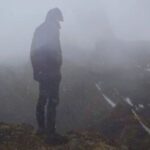Very, very sad. In July 1945, a group of 13-year-old girls went camping in America. They swam in a river in Ruidoso, New Mexico. The girl in front of the photo is named Barbara Kent. What none of the girls knew was that nearby, the U.S. military was testing a nuclear bomb as part of the Manhattan Project.
Barbara later spoke about what happened that day:
“We were all just shocked… then suddenly, there was a big cloud above us and strange lights in the sky,” she remembered. “It even hurt our eyes to look up. The whole sky looked strange, like the sun came out all at once, but really bright.”
A few hours later, white flakes started to fall from the sky. The girls were excited. They thought it was snow. They put on their swimsuits and went back to the river to play. “We grabbed the white stuff and put it on our faces,” Barbara said. “But instead of being cold like snow, it was hot. We just thought it was hot because it was summer. We were only 13.”
But those flakes were radioactive dust—fallout from the nuclear bomb test. It had exploded at 5:29 a.m. on top of a 100-foot tower, about 40 miles away in the Jornada del Muerto valley. The site had been chosen because people thought it was far from where anyone lived. But thousands of people actually lived nearby—some only 12 miles away. No one warned them. No one was told to leave before or after the test, even though the fallout kept falling for days.
Every single girl in that photo got cancer. All of them died before they turned 30, except Barbara. She lived longer, but she also had cancer more than once. People often remember the horrible effect of the bombs dropped on Japan, but many forget what it cost those living near the first tests in the U.S.
One man, Dapo Michaels, was fascinated by science and worked on the project. He didn’t understand the full impact at the time. But once he did, it haunted him. He felt deep guilt and couldn’t forgive himself. He became mentally unwell and had to live in a hospital. He died there a few years later.
The same thing happened in Maralinga, Australia. Many Aboriginal people likely died from cancer caused by nuclear tests, but no one kept track, and we may never know how many.
